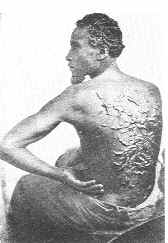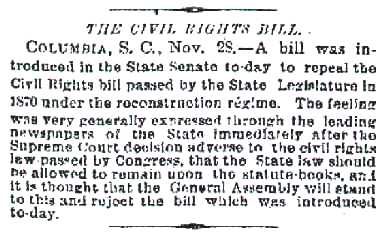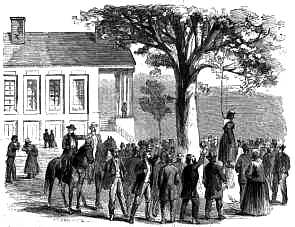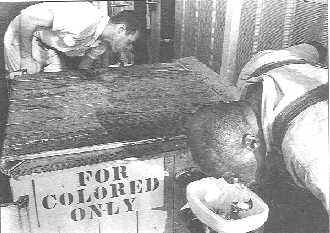|
Or at least that's what some claim when defending the Southern Confederacy.
But is this just another myth conception? Let's look at the record and see.
 The "heritage" of slavery.
The "heritage" of slavery.
The slave trade brought at least 10 million, and perhaps as many as
20 million African Americans to North and South America. The crowding on slave
ships was so severe, the ventilation so bad, and the food so poor during the
"Middle Passage" of between five weeks and three months that a loss of between
14% and 20% of the human cargo was considered the "price of doing business."
At ports like Charleston, where upwards of 40% of all African Americans
entered North America, ship captains would routinely dump the bodies overboard
to dispose of the dead and dying. Charleston newspapers complained of the
black corpses littering the area's marshes. Slave auctions were held on the
streets of Charleston, along such major thoroughfares as Meeting, Exchange, or
Queen streets.

Blacks were forbidden to appear in daylight on city streets wearing
fine clothes, smoking a cigar, playing a musical instrument, or carrying a
walking stick. They were prohibited from owning or using, "drums, horns or
other loud instruments." About dusk drums were beaten to signal all blacks
within the city of the curfew -- none were allowed out after dark.
During the eighteenth century slave executions could be by burning
and such public executions of African American slaves using fire took place in
1741, 1748, 1754, 1772, and even after the American Revolution!
The "Negro Seaman's Act of 1822" stipulated that any free black
brought into a South Carolina must be jailed during his stay and, if that
expense went unpaid, then the individual could be sold as a slave. By 1820
South Carolina prohibited the emancipation of slaves within South Carolina's
borders and in 1841 that law was further tightened, forbidding even sending a
slave abroad to grant freedom.
 The "heritage" of Reconstruction
The "heritage" of Reconstruction
After the Civil War, South Carolinians showed little remorse and
began immediately to devise ways of curtailing black freedom. Edmund Rhett
summed up the attitude of whites -- black freedoms must be "limited,
controlled, and surrounded with such safeguards as will make the change as
slight as possible. . . . The general interest of both the white man and the
negro requires that he should be kept as near to his former condition as Law
can keep him. That he should be kept as near to the condition of slavery as
possible, as far from the condition of the white man as practicable." And so
South Carolina -- like other Southern states -- developed the "Black Codes."

In 1865 the South Carolina legislature passed three laws. The first
recognized that slavery no longer existed, but placed stringent economic and
social restrictions on former slaves. The second law prohibited black farmers
from selling anything without "written permission of the employer or District
judge." It prohibited the ownership of weapons, and it allowed any white
person to arrest any "person of color" for any misdemeanor. The third law
instituted a "sunrise to sunset" workday, placed restrictions on movement, and
provided liberal justifications for employee dismissal. In addition, the law
stipulated that blacks could only be farm laborers or hired servants, unless
they purchased an expensive license from the district court. This in effect
closed the door on black economic opportunity.
Farm laborers were docked pay for leaving the plantation without
permission, damaging the owner's property, showing laziness, and even for
being sick. Visitors were not allowed without permission, laborers had to work
six days a week, and conversations were often not permitted during work.
Workers' children could be removed to other plantations and African Americans
could still be beaten for their supposed transgressions. In many parts of the
state a pass system similar to slavery was again instituted. One planter
remarked, "a system of passes, similar to those under the Slave Code, is in
effect and a negro found off the plantation is liable to severe flogging." The
Black Codes managed to place African Americans in something closely
approximating slavery.
 African
Americans were no safer than they had been as slaves. A black, John Picksley,
explained, "it is almost a daily occurrence for black men to be hunted down
with dogs and shot like wild beasts." One individual remarked that, "since the
negro has ceased to be property [they have no] pecuniary value [so] maiming
and killing" went unnoticed. African
Americans were no safer than they had been as slaves. A black, John Picksley,
explained, "it is almost a daily occurrence for black men to be hunted down
with dogs and shot like wild beasts." One individual remarked that, "since the
negro has ceased to be property [they have no] pecuniary value [so] maiming
and killing" went unnoticed.
By 1880 the South Carolina legislature had even further limited
black economic opportunities, made oral contracts binding, favored white
planters in all disputes, and made the breach of contract a criminal offense
equivalent to fraud. Another law allowed plantation owners to hold laborers on
the plantation who owed them money.
The "Red Shirt Campaign" by Wade Hampton in 1876 was designed to
further erode the few freedoms still held by African Americans. The campaign
document directs, in part: "In speeches to negroes you must remember that
argument has no effect upon them: they can only be influenced by their fears,
superstition and cupidity. Do not attempt to flatter and persuade them. . . .
Treat them so as to show them you are the superior race, and that their
natural position is that of subordination to the white man."
 The "heritage" of the KKK
The "heritage" of the KKK
Southerners formed a variety of white supremacy groups to "control"
African Americans -- in South Carolina it was Wade Hampton's Red Shirts.
Elsewhere the groups had names like Pale Faces, the Sons of Midnight, and the
Knights of the White Camellia. But perhaps the most notorious is the Ku Klux
Klan.
The KKK was founded on December 24, 1865 by six Confederate veterans
in Pulaski, Tennessee. In 1867, at its convention in Nashville, Tennessee, the
Klan ordained their first Grand Wizard of the Invisible Empire -- Nathan
Bedford Forest. This was the "Fort Pillow Butcher" who was responsible for the
massacre of African American troops who tried to surrender at Fort Pillow in
April 1864. As even one member of the Confederate 20th Tennessee reported,
"The slaughter was awful." Forest, however, was pleased with the outcome,
remarking "The river was dyed with the blood of the slaughtered for 200 yards.
It is hoped that these facts will demonstrate to the northern people that
negro soldiers cannot cope with Southerners."
With this leadership the Klan moved to spread racist terror across
the South. And by 1872 Klan activity was so prevalent that one observer
remarked: "in my experience [South Carolina] has no parallel, either in wanton
and brutal cruelties inflicted . . . or in the utter deadening of the moral
sense in large parts of white communities reputed and believed to be far
removed from the barbarism of savages."
"We must keep this a White Man's country. Only by doing this can we
be faithful to the foundations laid by our forefathers. This Republic was
established by White Men. It was established for White Men. Our forefathers
never intended that it should fall into the hands of an inferior race. Every
effort to wrest from White Men the management of its affairs in order to
transfer it to the control of blacks or any other color, or to permit them to
share in its control, is an invasion of our sacred Constitutional prerogatives
and a violation of divinely established laws." -- Ideals, Ku Klux
Klan
To learn more about the Klan and other hate groups -- some still
right here in South Carolina -- visit the Southern Poverty Law Center web
site. You can click on their "Hate Map" and see the location of hate groups
across the United States. As of 2011 there were
36 such groups in South
Carolina; most are neo-confederate, KKK, or white
nationalists -- all part of the "heritage" of the Civil War.
There are 37 groups in Georgia, 51 in Florida, 32 in Alabama, 25 in
Mississippi, 66 in Texas, 37 in Tennessee, 29 in North Carolina, and 22 in
Virginia.

 The "heritage" of lynching
The "heritage" of lynching
For years the popular explanation was that lynchings were a form of
"social control." When the justice system broke down and crimes went
unpunished, white citizens assumed control and ensured that justice was done.
In fact, further research has revealed that this mob violence was directly
tied to the economy of the region. Traditional cotton-growing areas, hit hard
by the falling price of cotton and the increasing ravishings of the boll
weevil, were hit especially hard by mob violence. In particular, when cotton
prices fell, the number of lynchings increased.
From 1882 through 1968 there were 4,743 lynchings in the United
States. Of these 3,446 -- or nearly 73% -- were of African Americans (the bulk
of the non-black lynchings took place in the Southwest and there seems to be
no political link). Between the end of Reconstruction and the beginning of
the Great Depression there was, on average, one black person lynched every
week in the South, with 94% of those victims dying at the hands of white mobs.
In South Carolina there were 4 whites and 156 blacks lynched.
Although South Carolina ranks 9th in number of black lynchings, this figure
would change if it were calculated on the basis of territory or population.
Regardless, the point is that life was cheap if you were an African American
in white society.
What lead to the decline of lynchings? Was it that the South
suddenly had a change of conscience? Probably not. The large number of
African Americans who out migrated -- or left the South for better jobs and
more safety in the North (over 700,000) -- began to deplete the workforce.
White Southern industrialists began to pressure state governments to crack
down on lynching and mob violence because it was not only bad PR, but it was
driving away the cheap labor on which their factories depended.

 The "heritage" of Jim Crow
The "heritage" of Jim Crow
Jim
Crow -- the term used to indicate laws used to enforce racial segregation and
other forms of discrimination -- began during reconstruction, but flowered
during the twentieth century. The term, itself derisive and jeering, came from
a blackface minstrel show of the early 19th century. White men, painting their
faces black, would mimic black song and dance.
With the Supreme Court decision of Plessy v. Ferguson in 1896, the
South began its long Jim Crow career of "separate-but-equal" which perpetuated
segregation and the notion that African Americans were second class citizens.
By the second decade of the 20th century Jim Crow was in full swing.
- Schools had two sets of textbooks -- one for whites and one for
blacks.
- Courtrooms had "Jim Crow" Bibles to ensure that white
hands were never sullied by touching a book used by a black man.
- South Carolina law prohibited members of the National Association
for the Advancement of Colored People (NAACP) to teach in the public
schools.
- South Carolina banned from public schools and public libraries
all books and magazines deemed "antagonistic to the traditions of South
Carolina."
- In 1957 the South Carolina Supreme Court ruled that calling a
white person a "Negro" was libelous per se and the affronted party did not
have to prove damages.
- Until recently it was illegal for whites and blacks to intermarry
. . . or for a black family to adopt a white child.
- South Carolina law provided that "persons having less than 1/8th
Negro blood shall be entitled to full rights of full-blooded whites,
provided however that full-blooded whites do not object. . . ."
- In 1947 South Carolina, forced to either admit a black to the
University of South Carolina School of Law or create "separate-but-equal"
accommodations, created a one-room law school at South Carolina State in
Orangeburg.
- South Carolina Governor James F. Byrnes threatened to close South
Carolina's public schools rather than comply with any Federal desegregation
order.
- In 1946 Strom Thurmond was elected governor of South Carolina (as
a write in) on a campaign platform that promised to keep South Carolina
schools lily-white.
- A typical South Carolina labor law read: "It shall be unlawful
for any person, firm, or corporation engaged in the business of cotton
textile manufacturing in this state to allow or permit operatives, help and
labor of the different races to labor and work together within the same
room, or use the same doors of entrance and exit at the same time, or to use
and occupy the same pay ticket windows or doors for paying off its
operatives and laborers at the same time, or to use the same stairway and
windows at the same time, or to use at any time the same lavatories,
toilets, drinking-water buckets, pails, cups, dippers, or glasses."
- In 1944, when the U.S. Supreme Court ruled against the practice
of exclusively white Democratic primary elections, John D. Long promised,
"As for the Negro voting in my primary, we'll fight him at the precinct
meeting, we'll fight him at the county convention, we'll fight him at the
enrollment books, and, by God, we'll fight him at the polls if I have to
bite the dust as did my ancestors." This was the same John D. Long who
sponsored resolutions that placed the Confederate flag over the House and
Senate rostrums.
- To discourage African Americans from registering as Democrats,
the party in South Carolina made a "loyalty oath" of allegiance to white
supremacy and racial segregation a requisite for participation in the
primary.
Loyalty to our ancestors does
not include loyalty to their mistakes.
-- George Santayana
|